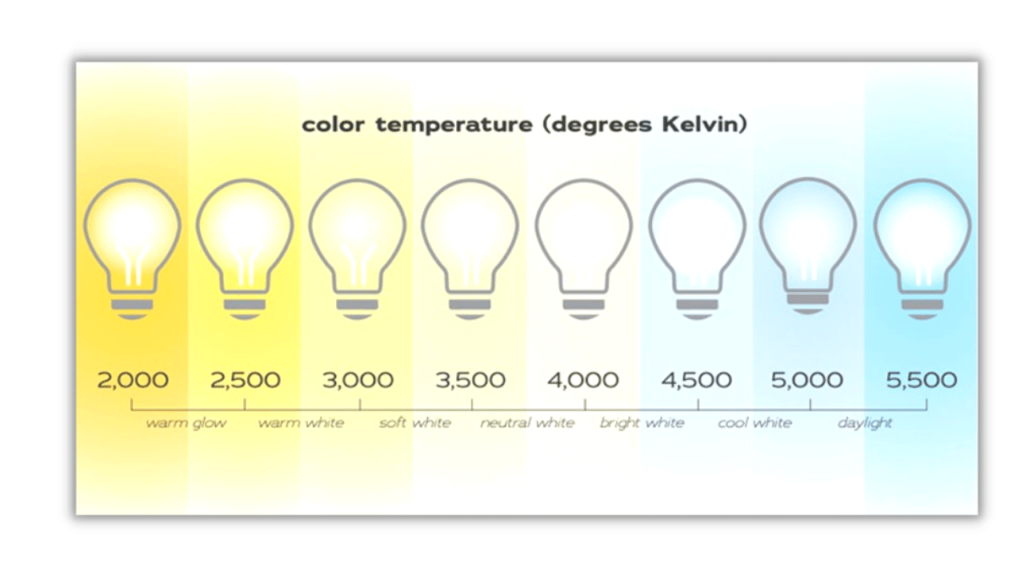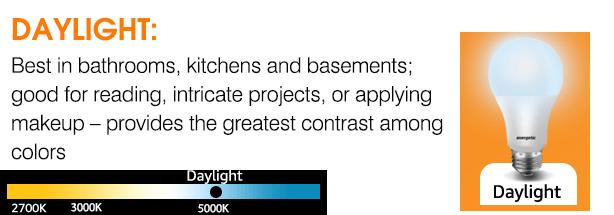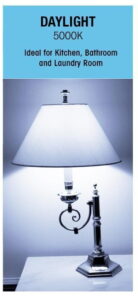Soft white vs daylight lightbulbs are the two primary types of incandescent light bulbs available at major retailers today. As a consumer, you’re not just getting what you pay for, but you’re also getting a variety of options and environmental considerations with these two kinds of incandescent bulbs.
Soft white is the most common color temperature used in photography. It is a warm light that creates a sense of comfort and calmness. When you see a soft white bulb in a room, you can imagine yourself sitting on a beach reading a book or enjoying a cup of tea. Daylight is cooler than soft white and creates a sense of clarity and contrast. It makes people feel awake and alert.
A good rule of thumb to follow is to keep your lights at 2700K. That’s the standard white point for most commercial and professional lighting. But if you’re using LED lighting, you may want to consider 6000K. That’s the “warm” side of the scale.
The Kelvin scale is used to measure the color temperature of light. It is used to help artists determine the color and brightness of a light source. The color temperature scale goes from 1, 000K up to 10, 000K. The lower the number the more yellow tones.
- Soft White (2700K)
- Daylight (5500-6500K)
- Cyan Hydrography (6000K)
Neutral Density Filters and Diffusion Materials: These are a range of color filters, which come in a variety of textured filters, that can be used to change the color temperature and color quality of light.
The Kelvin scale is used to measure the color temperature of light. It is used to help artists determine the color and brightness of a light source. The color temperature scale goes from 1, 000K up to 10, 000K. The lower the number the more yellow tones. The higher the number, the more blueish tones. .Soft
Table of Contents
Soft White vs Daylight
The color of the light is measured in Kelvins. The higher the Kelvin, the more blue or white that the light will be. Daylight is at 5000-6500 Kelvins, soft white is at 2700-3200 Kelvins.
Soft white lights are much more relaxing than daylight lights because they are not as bright and can be seen as warmer. Daylight lights on the other hand can cause eyestrain and headaches because it’s too bright and has a blue tint to them.
The key to choosing the right type of white for your painting is to understand the difference between soft white and daylight. Soft white is warmer and has more yellow tones to it while daylight is cooler and more neutral. I suggest using soft white for interior work because it gives off a more realistic feel to it.
It is helpful to compare both the 3000K and 4000K options. The 3000K is the standard “daylight” setting, and the 4000K is a warmer, more blue-leaning option. I use the 5000K option if I’m trying to mimic the look of a fluorescent light bulb. When choosing a color temperature, it’s important to understand what you want to achieve.

Soft White is the lightest and most neutral of all colors. It is a good choice for portraits, as well as landscapes. It is also an excellent choice for buildings and other architectural details.
Soft white is an artificial light that has more warmth to it. It is most often used for residential interiors and can be used in any room of the house. Soft white does not have the same luminosity as daylight, but the light from soft white still provides sufficient light for interior spaces.
If you are trying to achieve a natural look with your art, then you should use a daylight balance. This is because daylight creates more blueish tints than most other types of light sources. It is also important to remember that the color temperature of the light source doesn’t matter if it is mixed with other light sources.
If you are trying to create a realistic painting, then the light should be as accurate as possible. Soft white is used to reflect light from the sky. Hard white is used to reflect light from the sun.
What Are Soft White Bulb?
A soft white bulb is a type of light bulb that has a color temperature of 3,000-4,000K. It is considered to be the most natural type of lighting and it is also the most popular type of light bulb in the world.
A soft white bulb is often used for interior lighting because of the way it illuminates objects. However, if you want a white light that is more blue than orange, a soft white bulb is not the best option. You can get a more pure white light from a cool white bulb, which has a light that is cooler than a soft white bulb.
The 3000K bulb is the standard bulb used in professional photography and video and is also a popular choice in home lighting. It provides a more balanced color spectrum than the 2700K and is ideal for tasks like reading and detailed work.
Soft white bulbs are a very popular choice among interior designers because they add warmth to the space without being too bright or glaring. They are often used in rooms that have a lot of reds, oranges, or browns because the warm light they produce can accentuate these colors. Because of their versatility and low cost, they’re an excellent option for a variety of spaces including living rooms, bedrooms, kitchens, and more.
If you’re looking for a bulb that’s great for illuminating a room, and it’s not too bright, then you’ll want a soft white light. Soft white bulbs are warm, but they don’t cast a harsh glare that can be annoying for reading or completing a detailed task.

What Are Daylight Bulbs?
Daylight bulbs are types of light bulbs that offer natural light. They are typically used in offices, schools, and other spaces where people spend a lot of time.
Daylight bulbs are different than traditional fluorescent or incandescent bulbs. They emit white light, which is closer to the color temperature of natural daylight. This provides an increased sense of well-being and well-being while also improving productivity due to reduced eye strain.
It’s easy to think that daylight bulbs are expensive, but they are actually quite inexpensive when compared to traditional lighting. There are three main types of daylight bulbs, and they are all priced similarly. They range from 5000K to 6500K and are commonly used in homes and businesses to mimic natural light. You can also use them to make your workroom look inviting.
When lighting your home, you want to be sure that you are using the right bulbs. It’s not just about the color of the light, but also the type of bulb and where you place the bulbs in your home. A lightbulb is like any other appliance, so it needs to be placed in a particular spot in order to get the right effect.

Soft white vs daylight for bathrooms? Which one is better?
It depends on the type of light bulbs you are using. Soft white bulbs are better for bathrooms because they provide a warm, inviting feel. Daylight light bulbs on the other hand provide more natural light and can be used in areas where you need more illumination.
The most important thing to consider when choosing a light is how well it will light your subject. For example, if you’re painting a sunset, then a soft white light with a lower CRI (color rendering index) will give you a more natural-looking sunset. If you’re painting a bright white subject, then a harder light with a higher CRI will help you achieve a brighter white.
Soft white is the perfect choice for bathrooms because it has a warm undertone and is more suitable for a soothing environment. Daylight is great for bathrooms when you need a lot of natural light. I often use it for vanity applications because it’s beautiful and adds a lot of depth to the room.
A light source has two effects on the color of your subject matter: it either darkens or lightens it. The key is to figure out what type of light you are working under and make sure it’s the right one for the job. The two main types of lighting are artificial (from overhead) and natural (from a window).
There is a huge difference in the amount of light between the two pictures. This is a good example of why you should shoot in RAW mode when you take a picture. By shooting in RAW, you have the ability to make adjustments in post-processing without changing the actual data.
Soft white vs Daylight for Kitchens
The color of the kitchen is an important factor in the overall design. It can affect the mood, ambiance, and even the way that food tastes.
Kitchen lighting is a big deal. It can make or break the kitchen design and the ambiance of the room. For example, if you have a bright white kitchen with a single fluorescent light, it will feel like an operating room. On the other hand, if you have a dimly lit space with soft yellow lights and candles on the countertops, it will feel like home.
The lighting of your kitchen will depend on your preference and what you want to achieve with your design. If you are looking for more natural light in your space then soft white is perfect for you. However, if you want to create an intimate space with candlelight then daylight is more appropriate.
Kitchens are often the largest rooms in the house. As such, they need to be well lit. In fact, many people consider the kitchen to be the center of the home. If your kitchen has hardwood floors, it’s best to use a warm white light to highlight them. On the other hand, if you have tile or other types of flooring, you’ll want to use a cool white light to make the space feel more modern.
You can use a color wheel to find the perfect color for your cabinets. Think about how the light hits the room. If the sun is shining in through a window, the light will be cool, but if the sun is coming in from the side, it will be warm. Use that information to choose a color that you can live with.
Soft white light creates a more natural atmosphere and gives off a lovely glow to your space. I recommend using a soft white light when designing a traditional or transitional kitchen. Warmer light is less harsh than a daylight light fixture. It highlights wood grains and looks great on earthy tones. However, if you have a more contemporary kitchen, look for a cool white light in the range of 4000K 5000K.
I’ve read that the color of light coming in from the windows can have an effect on the color of the room, so I tested out three different colors of light: daylight,
Daylight +1, and daylight +2: The daylight +1 was a little bit too much for my kitchen cabinets, but the daylight +2 was great.
The daylight color temperature does provide a more task-oriented light that’s often needed in a kitchen. Even if you have white contemporary cabinets, look for cool white light, but not daylight.
How to Choose Between Soft White and Daylight Bulbs
The choice between soft white and daylight bulbs can be difficult. If you are looking for a relaxing and cozy atmosphere, soft white bulbs might be the best option for you. On the other hand, if you want to create a more energetic and uplifting environment, daytime light bulbs might be the best option for you. .
While soft white bulbs are often considered to be the most comfortable choice for people who want to relax and de-stress, daylight bulbs can be used in any setting. ,
Soft white and daylight bulbs are often recommended to office workers, who are prone to eye strain and other vision problems.
It’s important to understand the difference between soft white and daylight bulbs and when to use each for different lighting needs in your home.
Room Size
The size of the room is the most important factor when deciding between soft white and daylight bulbs. The size of the room is important because it will determine how much light you need, which will in turn determine what type of bulb to buy.
.If your room is a large size, you should consider daylight bulbs. Daylight bulbs are the most efficient light source and use the least electricity. If your room is a small size, you should consider soft white bulbs. Soft white light has a less intense color than daylight and it also uses less energy.
Paint color
The color of the paint in your room can make a significant difference to how you perceive the room. Soft white paint is a popular choice for most people, but daylight bulbs are also an option. Daylight bulbs provide more natural light, but soft white paint provides a warmer look.
The best way to decide on which color of paint to use is by looking at the colors that are already in your room and deciding which one will complement them best. If you have dark colors in your room, then using soft white paint should be a good idea. On the other hand, if you have lighter colors in your room, then using daylight bulbs might be a better idea.
Watts
Watts are a measure of how much power a bulb consumes. If you want to switch from incandescent light bulbs to LED light bulbs, then you probably want more than 120 watts.
Incandescent bulbs are less efficient than LED bulbs, they also produce less light. Instead of updating a 60W incandescent bulb, you would want to go with an LED bulb that gives off around 60W worth of light.
An LED light bulb uses 1/5th the power of an incandescent light bulb, but cannot produce the same amount of illumination. On average, a watt is defined as: one joule per second.
The best way to get the right amount of light is to measure the distance of your room and then choose the bulb wattage accordingly. For example, if you are in a 10×10 foot room, you will need a 60-watt bulb.
Why do we need LED bulbs with different color temperatures?
Lighting plays an important role in our life. It not only helps us to see things but also to control our mood. The color temperature of the light can affect our circadian rhythm and sleep quality. Different color temperatures are needed for different purposes, like reading or sleeping, so it is important to know the difference between them.
There are many factors that determine the overall experience of a video game. Ambient lighting, for example, will greatly affect the mood or feeling of your game by enforcing colors through the use of LED lights from the Kelvin chart. You need different types of lighting for different rooms inside the house and then there’s outdoor lighting, which should be chosen according to what you need.
A study by Harvard University found that sporting activities need higher levels of Kelvin, which is the measure of the light’s color temperature. This means that softer and warmer light would be better for comfortable conditions. Inside your home, you can include a combination of colors to create a soothing environment.
Choosing the best light for reading is often a combination of vision, mood, and task. Sometimes this requires the use of curtains or dimmer switches. Creating the right mood, as such, is not an issue, as there are an endless number of options out there.
Conclusion: Soft White vs Daylight
The conclusion of this article is that Soft White is the best choice for most people. It has been found that Daylight bulbs are not as efficient as Soft White, but they are the best if you have a specific purpose in mind. Most people want to save the environment and save money. Soft White bulbs are a great option because they are cheaper, last longer, and use less electricity than Daylight bulbs.
Related Post:
- Best Smart LED Strip Lights
- Best Led Third Brake Light Strip
- Led Strip Light Cover
- Best Black Light Led Strips
- Can LED Lights Cause A Fire?
- Best Rechargeable Led Light Strip
- How Long Do Led Strip Lights Last?